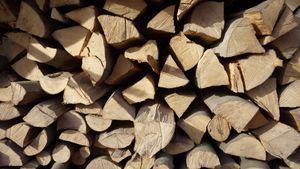Material:Wood
| MaterialInfoBox Wood | |
|---|---|

| |
| Synonyms: | timber (unprocessed), lumber (boards etc.); DE: Holz, Massivholz |
| On Site? | scraps of varying kinds & sizes (mostly engineered woods) |
| Suggested Tools: | saws, router, wood drill bits, laser cutter, CNC router, pyrography burner, planes, rasps, files, eccentric sander, sandpaper |
| Contains: | mainly cellulose and lignin |
Much like "plastic" and "metal", "wood" is a pretty broad term encompassing numerous different materials. Although they share many characteristics and can generally be shaped with the same tools, features like stability, grain (DE: Maserung) and surface finish vary greatly between different kinds of wood. In addition to the grain from growth rings (in non-tropical wood), knots can locally screw up your workpiece's properties where a branch used to sit.
Besides natural woods from different tree species that this page focuses on, there are engineered woods (DE: Holzwerkstoffe) with artificially enhanced advantages. Veneers can give such engineered woods the surface look of massive wood at first glance, and cut faces can be made more attractive by gluing on edge banding.
We have some scraps and reclaimed wood in store but you should expect to have to bring your own if you need large amounts or a specific variety.
Varieties
The list of woody plant species goes on for a while - here we collect some that have been used for woodworking in our community.
Wood is often separated into softwoods and hardwoods.
Hardwoods
Wood from broad-leaved trees (DE: Laubbäume) - harder due to (more or less) slower growth, therefore also more expensive than softwoods. Fast-growing trees like willows, poplars or birches produce much softer "hardwood" than others.
- beech (DE: Buche)
- commonly used in furniture and as a fuel (for smoking or as charcoal)
- oak (DE: Eiche)
- glued laminated posts are available in stores as Regalstollen
- Lukas is currently experimenting with drying and processing timber of various species
Softwoods
Wood from coniferous trees (DE: Nadelbäume) - fast growth, therefore commonly available at low prices with the downside of reduced strength and a much coarser grain. Again, not all softwoods are equally soft!
- spruce (DE: Fichte) or fir (DE: Tanne) - often undistinguished and labeled "FI/TA" at the store
- common construction beams
Marking
Pencils work great on wood, often used together with a square to obtain right angles. Most woods are also easily scratched by a pricking awl.
Shaping
The most common cutting tools for wood are handheld or powered saws. Using a router or woodworking chisels expands your threedimensional options.
We are also working on establishing CNC techniques such as CNC routing and laser cutting.
Sawing
As wood is fibrous, ripping it apart with the teeth of a blade can cause unsightly tearout/chipout/Ausriss. The splinters will always occur on the side where your blade exits the workpiece. There are a few precautions you can take against this effect though:
- zero clearance boards
- adhesive tape along the cut line
- please let us know which ones work well!
- working from the proper side of your workpiece in case the other one won't be seen anyway
Chamfering
"Breaking" sharp edges by cutting a chamfer (Fase) can have a great aesthetic effect and may improve your product's handling.
Common tools for chamfering (Anfasen) include planes, rasps or files, chisels and coarse sandpaper.
Steam Bending
Wood can be forced into a curved shape under exposure to heat and moisture (steam!), but this is something we do not have experimented with so far.
Gluing
Wood is commonly glued with wood glue but other adhesives may be needed when trying to glue other materials to wood.
Finishing
Sanding
Common grit sizes for sanding wood are 80, 120, 150 and 220. Check out this sanding basics video tutorial.
You may want to consider raising the grain before the last sanding pass if you are going to apply a water-based stain in the end.
Polishing
Very fine sandpaper grits and special polishing pads can make wood extremely smooth.
Planing
Some woodworkers don't use sandpaper at all but produce silky smooth surfaces with nothing but hand planes!
Oiling
To preserve or refresh the shine of a polished piece of wood, oil can be rubbed into the surface. We do not have a lot of experience with oil finishes yet.
Sourcing
Wood
- hardware stores
- Bauhaus in the city (limited selection) or Eppelheimer Straße (bigger)
- Obi in HD-Rohrbach Süd
- Hornbach in HD-Wieblingen
- Stadler Holzhandels GmbH in HD-Rohrbach Süd
- Holz Oberfeld in Leimen (not sure if they sell raw wood)
- Sägewerk Müller in Gaiberg (ca. 9 km)
- Holz Adrian in Schwetzingen (ca. 14 km)
- Gschwander Holzhandel in Heddesheim (ca. 16 km, towards Weinheim)
- Bellemann KG in Wiesloch (ca. 17 km)
- any carpenter shop (might be expensive)
- online:
Paint and Chemicals for Wood
- hardware stores (see above)
- Baufix in HD-Rohrbach Süd
Further Reading
- The Wood Database with information on pretty much every species you can imagine
- e.g. hardness, shrinkage, identification, project suitability